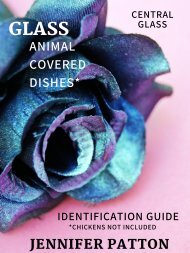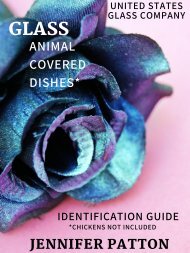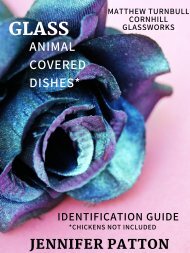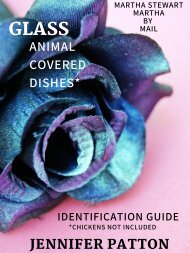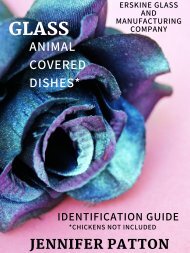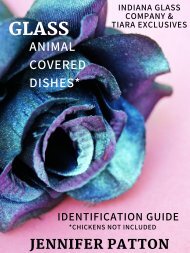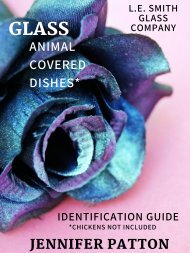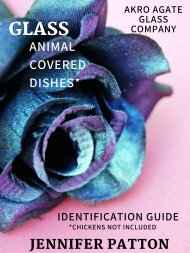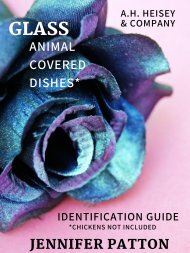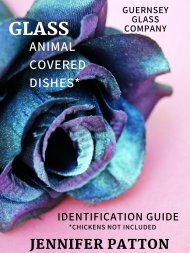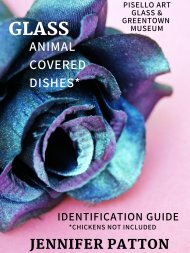Hocking Glass - Anchor Hocking
You also want an ePaper? Increase the reach of your titles
YUMPU automatically turns print PDFs into web optimized ePapers that Google loves.
GLASS<br />
HOCKING GLASS<br />
ANCHOR HOCKING<br />
ANIMAL<br />
COVERED <br />
DISHES*<br />
IDENTIFICATION GUIDE<br />
*CHICKENS NOT INCLUDED<br />
<br />
JENNIFER PATTON
ABOUT ME<br />
Hi! My name is Jen and this is a little bit about myself. First, I must say this project was a lot of fun.<br />
Like a book from my gradeschool years lol. I don’t know if children today still do book reports, but when<br />
I was in school, they were required and boy did I dread reading the assigned books then having to<br />
summarize them! I loved reading books that interested me and hopefully this will interest you. I created<br />
it for anyone that needs help with identification. For the novice glass collectors that buy animal covered<br />
dishes because they fall in love with the way they look or the type of animals they are, or simply for<br />
their colors. For the avid collectors who enjoy buying a few of each animal regardless of the maker. For<br />
the veteran collectors who may have hundreds of glass dishes who never cease to amaze me with their<br />
beautiful collections. For the people that have inherited or purchased someone’s entire collection or<br />
part of a collection and need help to identify things. For the people like me that are meticulous about<br />
every detail needing to label things and just absolutely need to know the whats, whens, whos, hows and<br />
whys of the animal dishes they own. For me, what started with one Asian yellow stained glass bunny on<br />
a nest, has flourished into a full blown collection of hundreds of mixed and matched animal covered<br />
“candy” dishes of all glass types and colors. No particular glass maker, just everything I can’t live<br />
without. LOL. Anyone that knows me would tell you that I stop at nothing, studying book after book<br />
searching for answers about my own glass animals until I find them. I have never been satisfied with a<br />
mystery….unless it involves me watching Columbo, my lifelong favorite television program! I am a<br />
mystery solver... a true detective. I get this from my Mother, Cindy -Sultana- Wheatley. I need to get to<br />
the bottom of a piece of unidentified glass. It drives me bananas not to know everything I can about<br />
each piece that I own. Next, I will tell you that the monetary value of my glassware means nothing to<br />
me. I collect it because I love it. However, unique and rare is always a find! Sure, like every collector, I<br />
love a bargain and have had to pass up many pieces that I could not afford. Ooooh the ones that got<br />
away. They haunt me. I can assure you that when I get a new addition to my collection, it has found its<br />
forever home. Someone before me and usually possibly before them owned these animal covered<br />
dishes making a kind of history that I can only imagine in my mind, its importance to each person. There<br />
is a reason behind every single glassware in every single dwelling. <strong>Glass</strong> symbolizes many things. It is<br />
proudly displayed. It is important to the person who owns it. I enjoy seeing the happiness glassware<br />
brings to people, especially these animal covered dishes. Who doesn’t love animals? I also enjoy seeing<br />
my collection knowing these pieces of history live on and hope that when I am long gone, they will be in<br />
other homes. My glass brings me peace; most peaceful in the evenings when the cabinet lights are on<br />
and the glass does its natural thing; what it was intended to do since the day it was made...look pretty! <br />
To me, it is reminiscent of having a year round Christmas Tree. <strong>Glass</strong> is AMAZING! I am a country girl<br />
through and through. I love all things nature. I am an avid bird watcher and an all around animal lover. I<br />
live in the beautiful state of Kentucky with my husband and our two dogs, Monkey and Johnnie, who by<br />
the way, is named after my all time favorite singer, Johnny Cash.
glass animal covered dishes<br />
© Jennifer patton<br />
No parts of this work may be reproduced without written permission<br />
from the copyright holder.<br />
No parts of this work may be reproduced for financial gain.<br />
Because this is a reference eBook, it may be downloaded and stored<br />
for educational purposes.
© <strong>Glass</strong> Animal Covered Dishes by Jennifer Patton<br />
Page 1<br />
hocking glass/anchor hocking<br />
<strong>Hocking</strong> <strong>Glass</strong> Company was started by 7 friends who purchased the old Lancaster Caron<br />
Company in Lancaster, Ohio. With further financial help by E. B. Good, <strong>Hocking</strong> <strong>Glass</strong><br />
Company began operations in 1905. The <strong>Hocking</strong> River nearby was the inspiration for<br />
the name of Isaac J. Collins' new glass company. The building had a nickname of "Black<br />
Cat" due to previous carbon dust emissions. For the next 21 years, <strong>Hocking</strong> <strong>Glass</strong> did well<br />
and expanded glassware productions. In 1924 "Black Cat" burned to the ground. It was a<br />
total loss. Isaac and his associates rebuilt and this time around, the building was named<br />
Plant 1 and was solely used for glass productions. During 1924, <strong>Hocking</strong> <strong>Glass</strong> bought<br />
controlling interest in Lancaster <strong>Glass</strong>. This became Plant 2. They also bought<br />
controlling interest in Standard <strong>Glass</strong> Co. with glass plants in both Canal Winchester,<br />
Ohio and Bremen, Ohio. In 1928, <strong>Hocking</strong> glass began producing over 30 items a minute<br />
using an automated glass pressing machine. Even smarter, during the stock market<br />
crash, <strong>Hocking</strong> glass developed a machine capable of producing 90 pieces of blown glass<br />
a minute which saved them during the Great Depression of 1929. The company survived<br />
by producing glassware quickly and in turn sold more glass.<br />
In 1931 <strong>Hocking</strong> glass bought 50% of General <strong>Glass</strong> Co. stocks and acquired Turner<br />
<strong>Glass</strong> Co. in Indiana. In 1934, along with General <strong>Glass</strong> Co., <strong>Hocking</strong> glass developed<br />
some of the first non returnable, one-way, beer bottles. The beer industry was the<br />
first to switch to non-returnable containers. This was convenient because people no<br />
longer needed to return the bottles. During World War II, because of material<br />
shortages, bottle deposit systems were common for beer and soda bottles in the U.S.<br />
After World War II, America's consumption patterns changed and nonreturnable<br />
containers gained in popularity. The environment quickly became littered with<br />
bottles. To solve this problem, recycling programs began.<br />
In 1937 <strong>Hocking</strong> glass company merged with the <strong>Anchor</strong> Cap and Closure<br />
Corporation to become <strong>Anchor</strong> <strong>Hocking</strong> <strong>Glass</strong> Company. From 1937-1983 the<br />
company operated the oldest glass manufacturing facility in the United States.<br />
In 1969 <strong>Anchor</strong> <strong>Hocking</strong> <strong>Glass</strong> Company dropped the word <strong>Glass</strong> from their name to<br />
become <strong>Anchor</strong> <strong>Hocking</strong>.<br />
New acquisitions, new locations and new products spanned over the course of the next<br />
few decades until The Newell Corporation acquired the <strong>Anchor</strong> <strong>Hocking</strong> Corporation on 2<br />
July 1987. In 2001, Newell Corporation sold several of its businesses, including <strong>Anchor</strong><br />
<strong>Hocking</strong> <strong>Glass</strong> Corporation, to Global Home Products. GHP specialized in turning around<br />
poor performing brands. Despite all cost-cutting efforts, Global Home Products and<br />
<strong>Anchor</strong> <strong>Hocking</strong> filed for Chapter 11 bankruptcy protection in April 2006 and the <strong>Anchor</strong><br />
<strong>Hocking</strong> assets were sold to a unit of Monomoy Capital Partners, a New York-based<br />
private equity firm.
© <strong>Glass</strong> Animal Covered Dishes by Jennifer Patton<br />
Page 2<br />
<strong>Hocking</strong> glass Pachyderm (elephant)<br />
<strong>Hocking</strong> <strong>Glass</strong> Elephant two piece dish was produced in the 1920's. The Elephant<br />
colors were: Crystal, Crystal Satin, Rose, Green and Vitrock. Vitrock is an opaque<br />
glass with fired-on colors made by <strong>Hocking</strong> <strong>Glass</strong> Co from 1934 to 1937, usually White<br />
opaque with Red, Green or Blue fired-on colors. The entire Elephant dish is lined or<br />
striped and shows an unusually thick, long tail that hangs against its right rear leg.<br />
Originally the Elephant dish held Vernafleur bath salts and were produced in 1928 to<br />
give as gifts to top Avon sales reps. Vernafleur bath salts were created in 1927 by<br />
California Perfume Company Avon Products, Inc. <strong>Hocking</strong> <strong>Glass</strong> continued making<br />
the Elephants and marketed them as candy dishes. Though the Elephant was created<br />
10 years before <strong>Hocking</strong> <strong>Glass</strong> would become <strong>Anchor</strong> <strong>Hocking</strong> <strong>Glass</strong>, the Elephant<br />
can also be considered an <strong>Anchor</strong> <strong>Hocking</strong> item. 4 1/2" high x 6 1/2" long.<br />
Rose and Green Pachyderms<br />
Denise Brouillette
© <strong>Glass</strong> Animal Covered Dishes by Jennifer Patton<br />
Page 3<br />
ANCHOR HOCKING FISH, pIG & turtle<br />
<strong>Anchor</strong> <strong>Hocking</strong> Company produced these covered dishes as part of a set of Curio<br />
Collectables. The Fish and Turtle are commonly found in Crystal and would have been<br />
produced between the 1940's-1950's. The Fish has been seen in Amber and Laser Blue. Laser<br />
Blue was a color in the 1970's, meaning there was a colored set of animals produced later.<br />
The Pig has only been seen in Brown. The Fish, Turtle, and Pig dishes are similar in shape and<br />
size. Fish is 3 1/2" high. Turtle is 3 3/4" high. Pig is 3 1/2" high. All measure roughly 3 1/2"<br />
around. Any color other than Crystal is very scarce to rare. <strong>Anchor</strong> <strong>Hocking</strong> also made a Hen<br />
in this round style which has been seen in Green and Laser Blue. All have the <strong>Anchor</strong> <strong>Hocking</strong><br />
logo on their base along with U.S.A. Fish and Pig have circle marks on their lids.<br />
Amber Fish **RARE** Laser Blue Fish **RARE** Brown Pig **RARE**<br />
These 3 are examples of <strong>Anchor</strong> <strong>Hocking</strong>'s possible sample items. It is rumored they<br />
were made for Avon in the 1970's but was never verified.<br />
Turtle, Fish and Pig in these colors are rare: Amber, Blue*, Brown and Green**.<br />
Photos by Shelly Broeker, from the Collection of Barbara Leach<br />
Clear Fish<br />
photos by Bryan Gebhardt of Oregon<br />
Original Fish Box<br />
photos by a private contributor<br />
*Shades of Blue: Ice Blue 1931-'38, Sapphire Blue 1937 and Laser Blue 1972-'73<br />
**Shades of Green: Green 1929-'43, Forest Green 1937, Avocado Green 1972-'76<br />
Hens have scarcely been seen in Green. Animals would be ***RARE*** in Green.
© <strong>Glass</strong> Animal Covered Dishes by Jennifer Patton<br />
Page 4<br />
<strong>Anchor</strong> <strong>Hocking</strong> Fish, pig & Turtle<br />
<strong>Anchor</strong> <strong>Hocking</strong> Logo 1937-1976<br />
Crystal Turtle<br />
Photos by Kelly Twin
© <strong>Glass</strong> Animal Covered Dishes by Jennifer Patton<br />
Page 5<br />
hocking glass/anchor hocking<br />
BIBLIOGRAPHY: <strong>Hocking</strong> <strong>Glass</strong>/<strong>Anchor</strong> <strong>Hocking</strong>:<br />
Online: www.anchorhockingmuseum.com/history -BIO<br />
Online: Wikipedia: History of bottle recycling in the United States<br />
Book: <strong>Glass</strong> Hen on Nest Covered Dishes Identification & Value Guide<br />
Second Edition Volume 1 by Shirley Smith, published by <strong>Glass</strong> Flakes<br />
Press, copyright 2015 Page 13-YEARS COLORS MADE<br />
Book: <strong>Glass</strong> Animals INCLUDING ANIMAL & FIGURAL RELATED ITEMS<br />
IDENTIFICATION & VALUES, SECOND EDITION by Dick & Pat Spencer,<br />
published by Collector Books, copyright 2004 by Dick and Pat Spencer<br />
Page 109-COLORS,PACHYDERM (ELEPHANT)<br />
Thank you for your permissions!<br />
Dick & Pat Spencer<br />
MAGWV, Tom Felt<br />
ALL photo contributors




